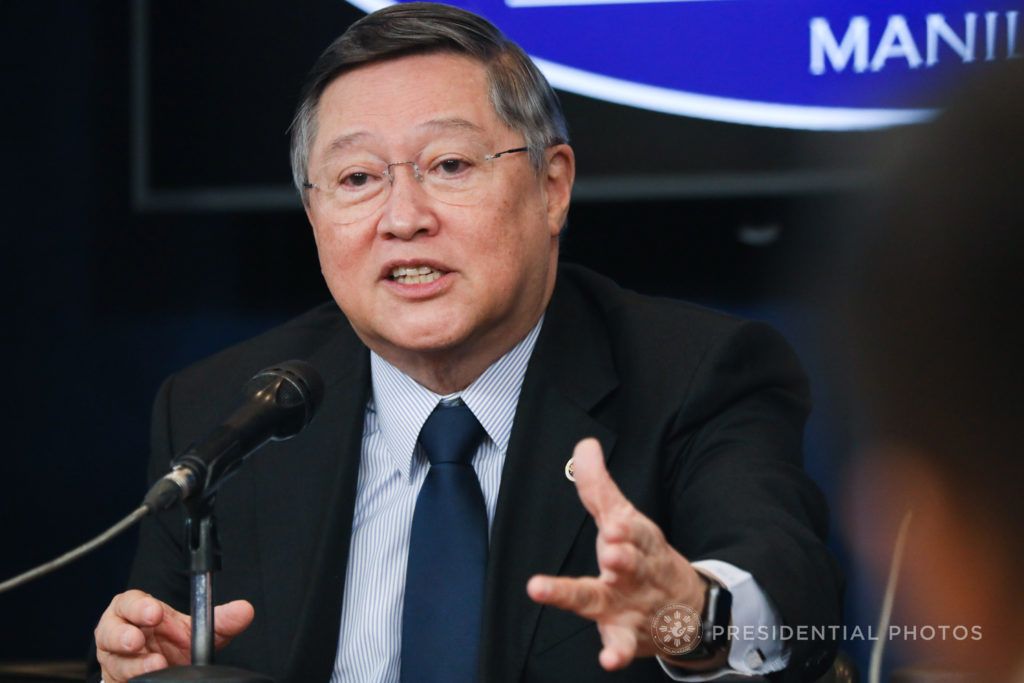
Finance Secretary Carlos Dominguez III. (File Photo by TOTO LOZANO / Presidential Photographers Division)
President Duterte’s chief economic manager is cold to legislators’ proposal to put in place a public debt cap, pointing to the need to maintain flexibility in pandemic response while the government kept fiscal prudence amid the prolonged fight against COVID-19.
During Monday’s House ways and means committee hearing on debt management, Finance Secretary Carlos Dominguez III noted that neighboring Indonesia had laws, which capped both debt and the budget deficit. However, the Indonesian government “threw [these laws] out” when it needed to borrow and spend more after the pandemic struck, the Finance chief said.
“What’s the point of having [a ceiling], if when you’re really going to breach it you just throw away the law? The important thing is that Congress already has the power—when it looks at the budget—to determine a debt cap. Essentially, the determination of the debt cap is the determination of how much we spend,” Dominguez said.
“That is the real debt cap—it is already in your hands. I don’t think, at this point in time, there is a need to put a debt cap and make the country very inflexible,” he told legislators.
Pending in the House of Representatives were bills aimed at creating an interagency Debt Management Board on top of a Congressional oversight committee to monitor and review both foreign and domestic borrowings.
Dominguez said all borrowings currently go through the scrutiny and approval of not only the Department of Finance and the Bureau of the Treasury, but also other agencies such as the Bangko Sentral ng Pilipinas, the National Economic and Development Authority, and ultimately, the Office of the President.
Borrowings
As the government ramped up borrowings to beef up its COVID-19 war chest, the Philippines’ debt-to-gross domestic product (GDP) ratio jumped to 54.6 percent last year from a record-low 39.6 percent in 2019.
Since debt accumulation grew faster than economic recovery, the debt-to-GDP, which reflected an economy’s ability to repay its obligations, as of end-June stood at 60.4 percent —higher than the 60-percent threshold which credit rating agencies considered a manageable public debt level among emerging markets.
Debt-to-GDP had been projected to end 2021 at a 16-year high of 59.1 percent. Outstanding debt will reach a record P11.73 trillion by yearend.
But Dominguez said the government needed to borrow more so it can also spend more amid the protracted pandemic, pointing out that public expenditures accounted for one-fourth of the economy.
“What sets the Philippines apart is that we entered 2020 with a historic low debt-to-GDP ratio—this means that we could better absorb additional borrowings than other countries whose debt ratios were already at 60 percent before the pandemic. Therefore, the 15-percentage point increase in our debt-to-GDP ratio in 2020 is still within the prescribed bounds of fiscal viability and the experience of our neighbors and rating peers globally,” Dominguez said.
Sustainability
“The sustainability of debt depends on two things: the cost and the ability to generate economic activity to pay it off … If we did not increase the level of public spending through borrowings, the domestic economy would have collapsed. This event would have inflicted a far more painful toll on our people,” the Finance chief added.
Asked how much worse the economy could have tanked if the government did not ramp up spending as well as borrowings amid the pandemic, Dominguez replied that it would have depended on which expenditures were reduced.
“Is it right to incur debt? Yes. To fund our people’s needs. However, we must use our borrowings in a prudent manner. We should use them to beef up our health requirements and to generate productive economic activity. If we do not do these things, the economy will collapse even further,” he said.
During the same hearing, National Treasurer Rosalia de Leon noted that the bulk or at least 70 percent of the national government’s yearly borrowings were being sourced from the domestic debt market to favorably take advantage of liquidity onshore. Dominguez added that this tack of bigger local borrowings against external financing also reduced foreign exchange risks. INQ